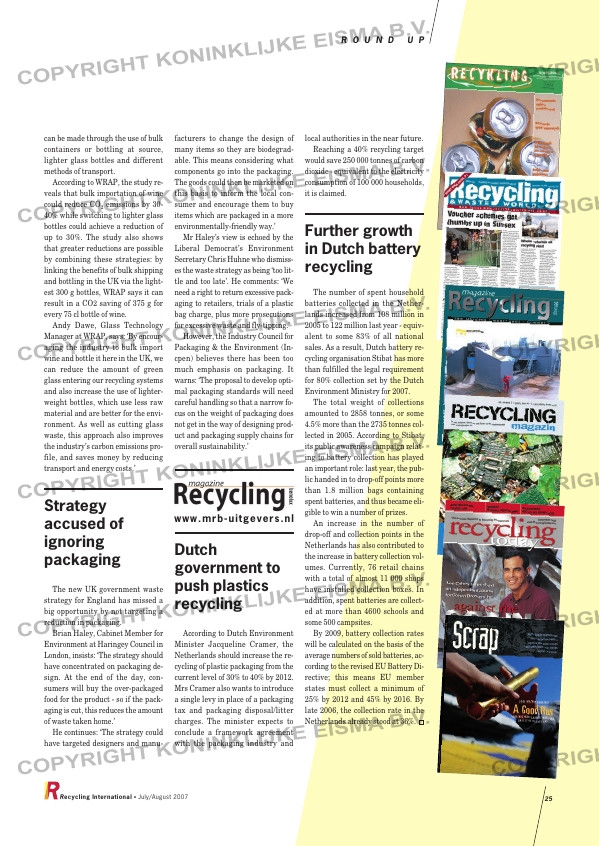Page 25 from: July / August 2007

can be made through the use of bulk
containers or bottling at source,
lighter glass bottles and different
methods of transport.
According to WRAP, the study re-
veals that bulk importation of wine
could reduce CO2 emissions by 30-
40% while switching to lighter glass
bottles could achieve a reduction of
up to 30%. The study also shows
that greater reductions are possible
by combining these strategies: by
linking the benefits of bulk shipping
and bottling in the UK via the light-
est 300 g bottles, WRAP says it can
result in a CO2 saving of 375 g for
every 75 cl bottle of wine.
Andy Dawe, Glass Technology
Manager at WRAP, says: ‘By encour-
aging the industry to bulk import
wine and bottle it here in the UK, we
can reduce the amount of green
glass entering our recycling systems
and also increase the use of lighter-
weight bottles, which use less raw
material and are better for the envi-
ronment. As well as cutting glass
waste, this approach also improves
the industry’s carbon emissions pro-
file, and saves money by reducing
transport and energy costs.’
Strategy
accused of
ignoring
packaging
The new UK government waste
strategy for England has missed a
big opportunity by not targeting a
reduction in packaging.
Brian Haley, Cabinet Member for
Environment at Haringey Council in
London, insists: ‘The strategy should
have concentrated on packaging de-
sign. At the end of the day, con-
sumers will buy the over-packaged
food for the product – so if the pack-
aging is cut, this reduces the amount
of waste taken home.’
He continues: ‘The strategy could
have targeted designers and manu-
facturers to change the design of
many items so they are biodegrad-
able. This means considering what
components go into the packaging.
The goods could then be marketed on
this basis to inform the local con-
sumer and encourage them to buy
items which are packaged in a more
environmentally-friendly way.’
Mr Haley’s view is echoed by the
Liberal Democrat’s Environment
Secretary Chris Huhne who dismiss-
es the waste strategy as being ‘too lit-
tle and too late’. He comments: ‘We
need a right to return excessive pack-
aging to retailers, trials of a plastic
bag charge, plus more prosecutions
for excessive waste and fly-tipping.’
However, the Industry Council for
Packaging & the Environment (In-
cpen) believes there has been too
much emphasis on packaging. It
warns: ‘The proposal to develop opti-
mal packaging standards will need
careful handling so that a narrow fo-
cus on the weight of packaging does
not get in the way of designing prod-
uct and packaging supply chains for
overall sustainability.’
Dutch
government to
push plastics
recycling
According to Dutch Environment
Minister Jacqueline Cramer, the
Netherlands should increase the re-
cycling of plastic packaging from the
current level of 30% to 40% by 2012.
Mrs Cramer also wants to introduce
a single levy in place of a packaging
tax and packaging disposal/litter
charges. The minister expects to
conclude a framework agreement
with the packaging industry and
local authorities in the near future.
Reaching a 40% recycling target
would save 250 000 tonnes of carbon
dioxide – equivalent to the electricity
consumption of 100 000 households,
it is claimed.
Further growth
in Dutch battery
recycling
The number of spent household
batteries collected in the Nether-
lands increased from 108 million in
2005 to 122 million last year – equiv-
alent to some 83% of all national
sales. As a result, Dutch battery re-
cycling organisation Stibat has more
than fulfilled the legal requirement
for 80% collection set by the Dutch
Environment Ministry for 2007.
The total weight of collections
amounted to 2858 tonnes, or some
4.5% more than the 2735 tonnes col-
lected in 2005. According to Stibat,
its public awareness campaign relat-
ing to battery collection has played
an important role: last year, the pub-
lic handed in to drop-off points more
than 1.8 million bags containing
spent batteries, and thus became eli-
gible to win a number of prizes.
An increase in the number of
drop-off and collection points in the
Netherlands has also contributed to
the increase in battery collection vol-
umes. Currently, 76 retail chains
with a total of almost 11 000 shops
have installed collection boxes. In
addition, spent batteries are collect-
ed at more than 4600 schools and
some 500 campsites.
By 2009, battery collection rates
will be calculated on the basis of the
average numbers of sold batteries, ac-
cording to the revised EU Battery Di-
rective; this means EU member
states must collect a minimum of
25% by 2012 and 45% by 2016. By
late 2006, the collection rate in the
Netherlands already stood at 36%.
R O U N D U P
www.mrb-uit gev ers.nl
Recycling International • July/August 2007 25
RI_039 Round Up:Round Up 07-08-2007 13:57 Pagina 25



